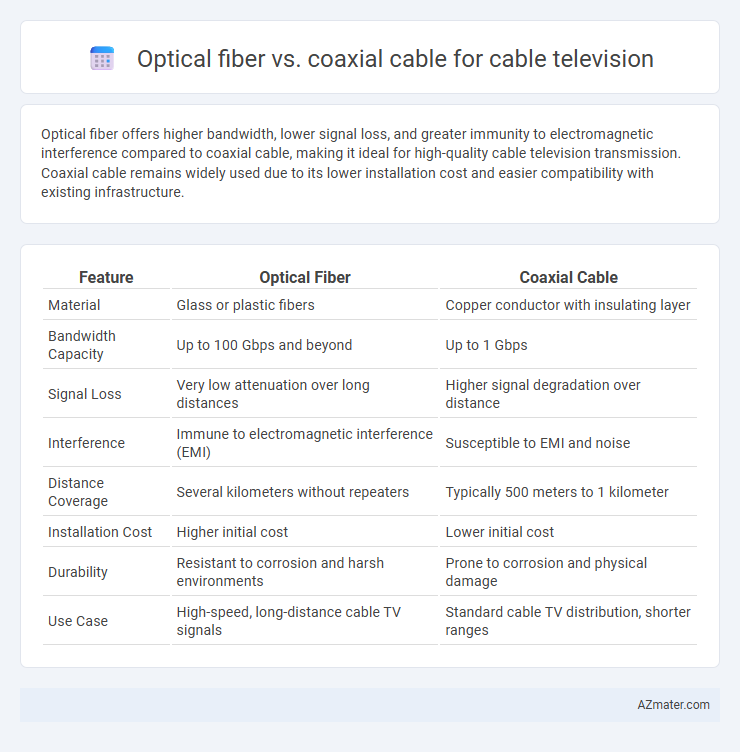Optical fiber offers higher bandwidth, lower signal loss, and greater immunity to electromagnetic interference compared to coaxial cable, making it ideal for high-quality cable television transmission. Coaxial cable remains widely used due to its lower installation cost and easier compatibility with existing infrastructure.
Table of Comparison
| Feature | Optical Fiber | Coaxial Cable |
|---|---|---|
| Material | Glass or plastic fibers | Copper conductor with insulating layer |
| Bandwidth Capacity | Up to 100 Gbps and beyond | Up to 1 Gbps |
| Signal Loss | Very low attenuation over long distances | Higher signal degradation over distance |
| Interference | Immune to electromagnetic interference (EMI) | Susceptible to EMI and noise |
| Distance Coverage | Several kilometers without repeaters | Typically 500 meters to 1 kilometer |
| Installation Cost | Higher initial cost | Lower initial cost |
| Durability | Resistant to corrosion and harsh environments | Prone to corrosion and physical damage |
| Use Case | High-speed, long-distance cable TV signals | Standard cable TV distribution, shorter ranges |
Introduction to Cable Television Transmission
Cable television transmission relies on effective signal delivery through physical media, with optical fiber and coaxial cable as primary options. Optical fiber offers superior bandwidth, lower signal attenuation, and resistance to electromagnetic interference, enabling higher quality video and extended transmission distances ideal for modern high-definition and digital broadcasts. Coaxial cable, while more susceptible to signal degradation and limited bandwidth, remains widely used due to its cost-effectiveness and established infrastructure in traditional cable TV networks.
What is Optical Fiber?
Optical fiber is a high-speed transmission medium made of thin strands of glass or plastic that transmit data as light signals, enabling superior bandwidth and minimal signal loss for cable television. Unlike coaxial cable, which uses electrical signals over copper wiring, optical fiber supports longer distances without degradation and offers greater resistance to electromagnetic interference. This makes optical fiber the preferred choice for delivering high-definition television and interactive services with enhanced reliability and speed.
What is Coaxial Cable?
Coaxial cable, characterized by its copper core surrounded by insulating layers and a metal shield, is widely used in cable television systems for its ability to transmit high-frequency signals with minimal interference. Unlike optical fiber, which uses light to carry data, coaxial cable transmits electrical signals, making it more susceptible to signal degradation over long distances but easier to install in existing infrastructures. This traditional medium supports cable television by balancing cost-effectiveness and sufficient bandwidth for delivering standard and high-definition TV channels.
Signal Quality and Bandwidth Comparison
Optical fiber provides significantly higher signal quality for cable television by minimizing electromagnetic interference and signal degradation over long distances, unlike coaxial cables which are more susceptible to noise and attenuation. The bandwidth capacity of optical fiber vastly exceeds that of coaxial cable, supporting gigabit speeds essential for high-definition and ultra-high-definition content streaming. This superior signal integrity and expanded bandwidth make optical fiber the preferred choice for modern cable TV infrastructure.
Transmission Distance and Attenuation
Optical fiber offers significantly greater transmission distances for cable television signals compared to coaxial cable, often spanning tens of kilometers without signal degradation. Attenuation in optical fiber is substantially lower, typically around 0.2 dB per kilometer, whereas coaxial cable experiences higher signal loss, especially over long runs, usually between 1 to 5 dB per 100 meters. These characteristics make optical fiber more suitable for modern cable TV networks requiring high bandwidth and long-distance transmission with minimal signal loss.
Installation and Maintenance Differences
Optical fiber cables require specialized equipment and skilled technicians for installation due to their delicate glass strands and precise splicing techniques, making the process more complex compared to coaxial cables. Coaxial cable installations are generally easier and faster, utilizing standard connectors and tools familiar to most technicians. Maintenance of optical fiber involves checking for signal attenuation and fiber breaks with optical time-domain reflectometers, whereas coaxial cable maintenance often focuses on physical damage and signal interference, with simpler diagnostic tools.
Cost Analysis: Optical Fiber vs Coaxial Cable
Optical fiber offers higher installation costs compared to coaxial cable due to advanced materials and specialized labor requirements but provides lower long-term maintenance expenses and greater bandwidth capacity for cable television. Coaxial cable has a lower initial investment and simpler deployment but incurs higher maintenance costs over time and limited data transmission speed. Evaluating total cost of ownership favors optical fiber for future-proofing despite upfront expenditure.
Reliability and Durability in Cable TV Delivery
Optical fiber offers superior reliability and durability compared to coaxial cable for cable television delivery due to its resistance to electromagnetic interference and signal degradation over long distances. Unlike coaxial cables, which are prone to corrosion and physical wear, optical fibers are made from glass or plastic that withstand harsh environmental conditions, ensuring consistent signal quality. This enhanced durability reduces maintenance costs and service interruptions, making optical fiber the preferred choice for modern cable TV infrastructure.
Future-Proofing: Scalability and Upgradability
Optical fiber offers superior future-proofing for cable television due to its immense bandwidth capacity and ability to support higher data rates over longer distances without signal degradation. Its scalability makes it easily upgradable to meet increasing demand for 4K/8K streaming, interactive services, and broadband internet integration. Coaxial cable, while still effective for current applications, faces limitations in bandwidth and signal quality, making it less adaptable to rapidly evolving content delivery standards and future technological advances.
Conclusion: Choosing the Best Option for Cable Television
Optical fiber offers superior bandwidth, lower signal attenuation, and immunity to electromagnetic interference, making it the optimal choice for high-quality, future-proof cable television services. Coaxial cable remains a cost-effective solution for shorter distances and less demanding setups but falls short in delivering ultra-high-definition content and fast internet integration. Selecting optical fiber ensures scalability, enhanced signal quality, and long-term investment benefits for cable television infrastructure.

Infographic: Optical fiber vs Coaxial cable for Cable television
 azmater.com
azmater.com